Comparative Analysis of Early Childhood Education in Australia
VerifiedAdded on 2022/09/23
|9
|2663
|20
Essay
AI Summary
This essay provides an analysis of early childhood education approaches across various states and territories of Australia. It explores the diverse methodologies employed in early childhood documentation, planning, and assessment, highlighting the unique perspectives of states such as South Australia, Northern Territory, Western Australia, Victoria, and Tasmania. The essay delves into the curriculum frameworks, pedagogical approaches, and learning outcomes emphasized by each state, including the Early Years Learning Framework (EYLF) and the Victorian Early Years Learning and Development Framework (VEYLDF). It underscores the importance of inclusive and flexible curricula, the significance of educators' roles in fostering children's development, and the recognition of the early childhood period as a crucial phase for learning and skill-building. The essay also touches upon the varying age ranges considered for early childhood education and the impact of these educational experiences on children's development. The essay aims to provide a comprehensive overview of the landscape of early childhood education in Australia, emphasizing the crucial role of early education in shaping children's futures.
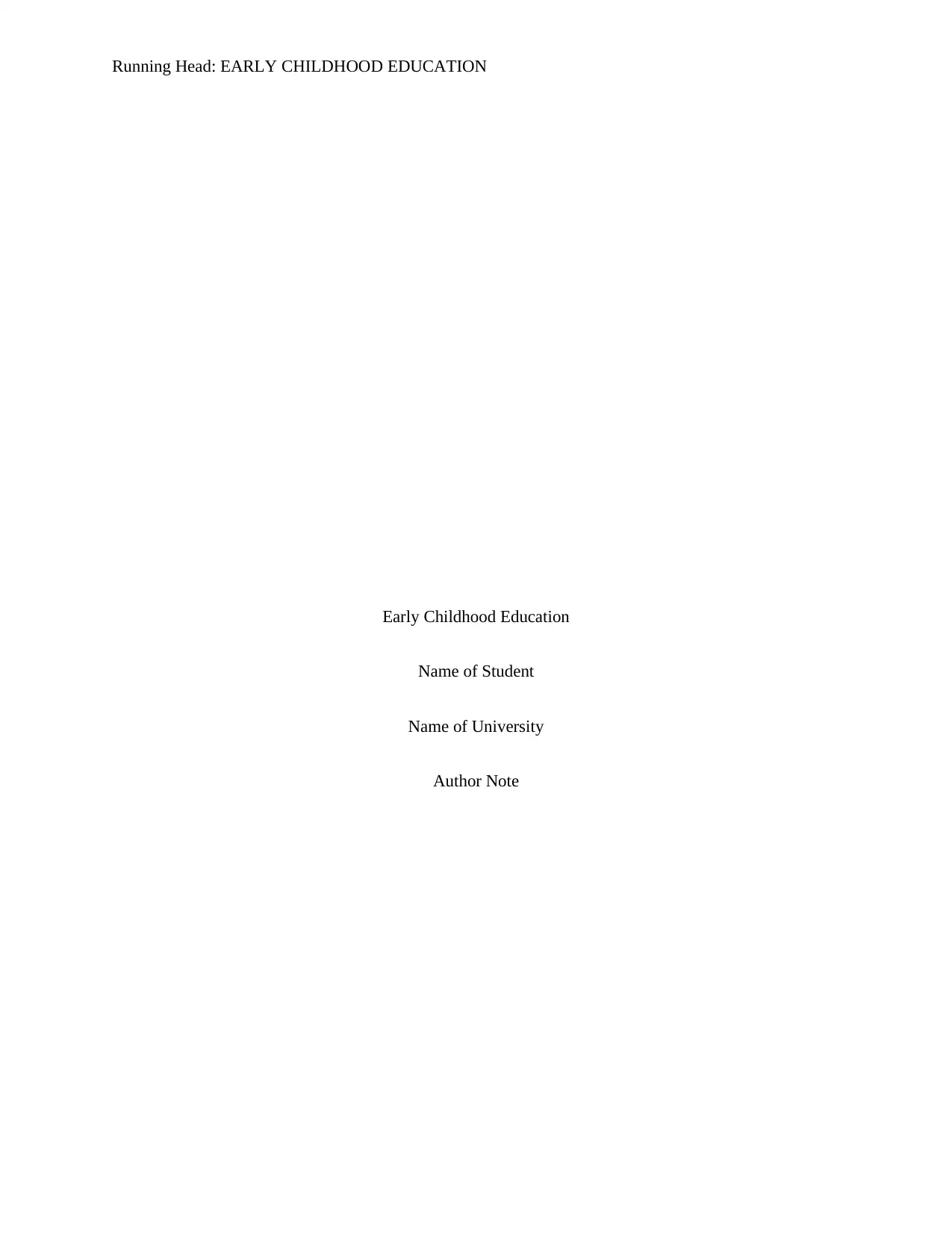
Running Head: EARLY CHILDHOOD EDUCATION
Early Childhood Education
Name of Student
Name of University
Author Note
Early Childhood Education
Name of Student
Name of University
Author Note
Paraphrase This Document
Need a fresh take? Get an instant paraphrase of this document with our AI Paraphraser
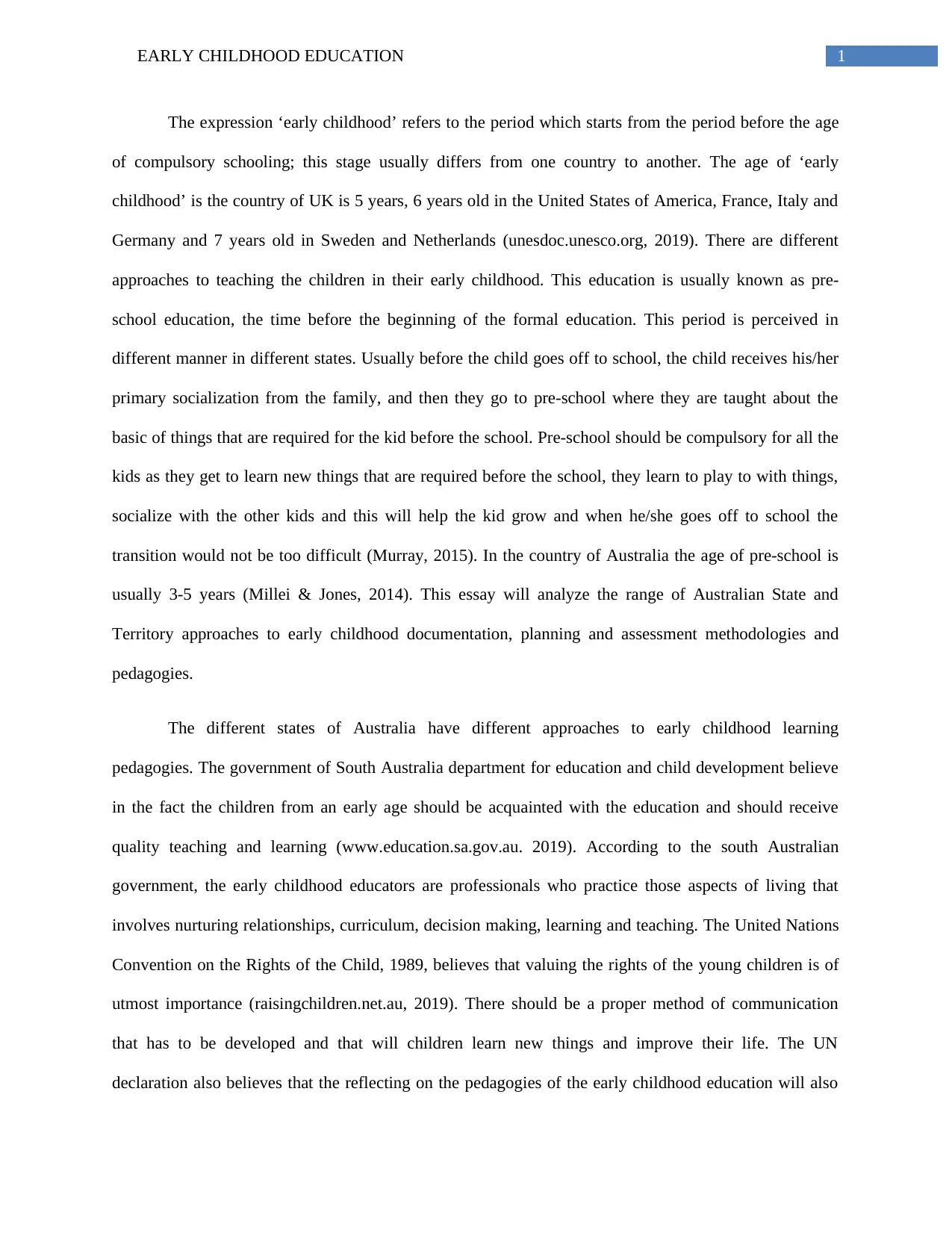
1EARLY CHILDHOOD EDUCATION
The expression ‘early childhood’ refers to the period which starts from the period before the age
of compulsory schooling; this stage usually differs from one country to another. The age of ‘early
childhood’ is the country of UK is 5 years, 6 years old in the United States of America, France, Italy and
Germany and 7 years old in Sweden and Netherlands (unesdoc.unesco.org, 2019). There are different
approaches to teaching the children in their early childhood. This education is usually known as pre-
school education, the time before the beginning of the formal education. This period is perceived in
different manner in different states. Usually before the child goes off to school, the child receives his/her
primary socialization from the family, and then they go to pre-school where they are taught about the
basic of things that are required for the kid before the school. Pre-school should be compulsory for all the
kids as they get to learn new things that are required before the school, they learn to play to with things,
socialize with the other kids and this will help the kid grow and when he/she goes off to school the
transition would not be too difficult (Murray, 2015). In the country of Australia the age of pre-school is
usually 3-5 years (Millei & Jones, 2014). This essay will analyze the range of Australian State and
Territory approaches to early childhood documentation, planning and assessment methodologies and
pedagogies.
The different states of Australia have different approaches to early childhood learning
pedagogies. The government of South Australia department for education and child development believe
in the fact the children from an early age should be acquainted with the education and should receive
quality teaching and learning (www.education.sa.gov.au. 2019). According to the south Australian
government, the early childhood educators are professionals who practice those aspects of living that
involves nurturing relationships, curriculum, decision making, learning and teaching. The United Nations
Convention on the Rights of the Child, 1989, believes that valuing the rights of the young children is of
utmost importance (raisingchildren.net.au, 2019). There should be a proper method of communication
that has to be developed and that will children learn new things and improve their life. The UN
declaration also believes that the reflecting on the pedagogies of the early childhood education will also
The expression ‘early childhood’ refers to the period which starts from the period before the age
of compulsory schooling; this stage usually differs from one country to another. The age of ‘early
childhood’ is the country of UK is 5 years, 6 years old in the United States of America, France, Italy and
Germany and 7 years old in Sweden and Netherlands (unesdoc.unesco.org, 2019). There are different
approaches to teaching the children in their early childhood. This education is usually known as pre-
school education, the time before the beginning of the formal education. This period is perceived in
different manner in different states. Usually before the child goes off to school, the child receives his/her
primary socialization from the family, and then they go to pre-school where they are taught about the
basic of things that are required for the kid before the school. Pre-school should be compulsory for all the
kids as they get to learn new things that are required before the school, they learn to play to with things,
socialize with the other kids and this will help the kid grow and when he/she goes off to school the
transition would not be too difficult (Murray, 2015). In the country of Australia the age of pre-school is
usually 3-5 years (Millei & Jones, 2014). This essay will analyze the range of Australian State and
Territory approaches to early childhood documentation, planning and assessment methodologies and
pedagogies.
The different states of Australia have different approaches to early childhood learning
pedagogies. The government of South Australia department for education and child development believe
in the fact the children from an early age should be acquainted with the education and should receive
quality teaching and learning (www.education.sa.gov.au. 2019). According to the south Australian
government, the early childhood educators are professionals who practice those aspects of living that
involves nurturing relationships, curriculum, decision making, learning and teaching. The United Nations
Convention on the Rights of the Child, 1989, believes that valuing the rights of the young children is of
utmost importance (raisingchildren.net.au, 2019). There should be a proper method of communication
that has to be developed and that will children learn new things and improve their life. The UN
declaration also believes that the reflecting on the pedagogies of the early childhood education will also
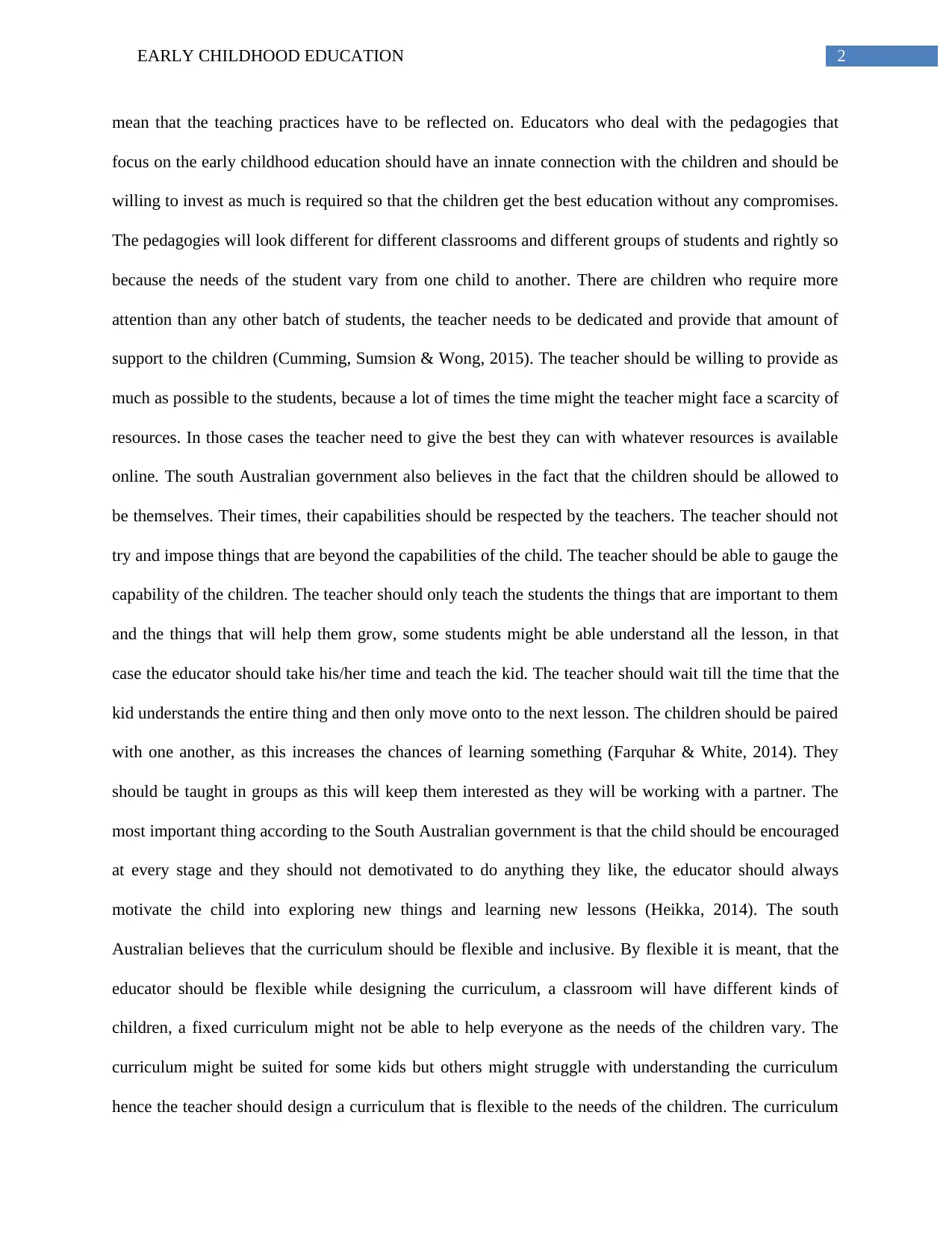
2EARLY CHILDHOOD EDUCATION
mean that the teaching practices have to be reflected on. Educators who deal with the pedagogies that
focus on the early childhood education should have an innate connection with the children and should be
willing to invest as much is required so that the children get the best education without any compromises.
The pedagogies will look different for different classrooms and different groups of students and rightly so
because the needs of the student vary from one child to another. There are children who require more
attention than any other batch of students, the teacher needs to be dedicated and provide that amount of
support to the children (Cumming, Sumsion & Wong, 2015). The teacher should be willing to provide as
much as possible to the students, because a lot of times the time might the teacher might face a scarcity of
resources. In those cases the teacher need to give the best they can with whatever resources is available
online. The south Australian government also believes in the fact that the children should be allowed to
be themselves. Their times, their capabilities should be respected by the teachers. The teacher should not
try and impose things that are beyond the capabilities of the child. The teacher should be able to gauge the
capability of the children. The teacher should only teach the students the things that are important to them
and the things that will help them grow, some students might be able understand all the lesson, in that
case the educator should take his/her time and teach the kid. The teacher should wait till the time that the
kid understands the entire thing and then only move onto to the next lesson. The children should be paired
with one another, as this increases the chances of learning something (Farquhar & White, 2014). They
should be taught in groups as this will keep them interested as they will be working with a partner. The
most important thing according to the South Australian government is that the child should be encouraged
at every stage and they should not demotivated to do anything they like, the educator should always
motivate the child into exploring new things and learning new lessons (Heikka, 2014). The south
Australian believes that the curriculum should be flexible and inclusive. By flexible it is meant, that the
educator should be flexible while designing the curriculum, a classroom will have different kinds of
children, a fixed curriculum might not be able to help everyone as the needs of the children vary. The
curriculum might be suited for some kids but others might struggle with understanding the curriculum
hence the teacher should design a curriculum that is flexible to the needs of the children. The curriculum
mean that the teaching practices have to be reflected on. Educators who deal with the pedagogies that
focus on the early childhood education should have an innate connection with the children and should be
willing to invest as much is required so that the children get the best education without any compromises.
The pedagogies will look different for different classrooms and different groups of students and rightly so
because the needs of the student vary from one child to another. There are children who require more
attention than any other batch of students, the teacher needs to be dedicated and provide that amount of
support to the children (Cumming, Sumsion & Wong, 2015). The teacher should be willing to provide as
much as possible to the students, because a lot of times the time might the teacher might face a scarcity of
resources. In those cases the teacher need to give the best they can with whatever resources is available
online. The south Australian government also believes in the fact that the children should be allowed to
be themselves. Their times, their capabilities should be respected by the teachers. The teacher should not
try and impose things that are beyond the capabilities of the child. The teacher should be able to gauge the
capability of the children. The teacher should only teach the students the things that are important to them
and the things that will help them grow, some students might be able understand all the lesson, in that
case the educator should take his/her time and teach the kid. The teacher should wait till the time that the
kid understands the entire thing and then only move onto to the next lesson. The children should be paired
with one another, as this increases the chances of learning something (Farquhar & White, 2014). They
should be taught in groups as this will keep them interested as they will be working with a partner. The
most important thing according to the South Australian government is that the child should be encouraged
at every stage and they should not demotivated to do anything they like, the educator should always
motivate the child into exploring new things and learning new lessons (Heikka, 2014). The south
Australian believes that the curriculum should be flexible and inclusive. By flexible it is meant, that the
educator should be flexible while designing the curriculum, a classroom will have different kinds of
children, a fixed curriculum might not be able to help everyone as the needs of the children vary. The
curriculum might be suited for some kids but others might struggle with understanding the curriculum
hence the teacher should design a curriculum that is flexible to the needs of the children. The curriculum
⊘ This is a preview!⊘
Do you want full access?
Subscribe today to unlock all pages.

Trusted by 1+ million students worldwide
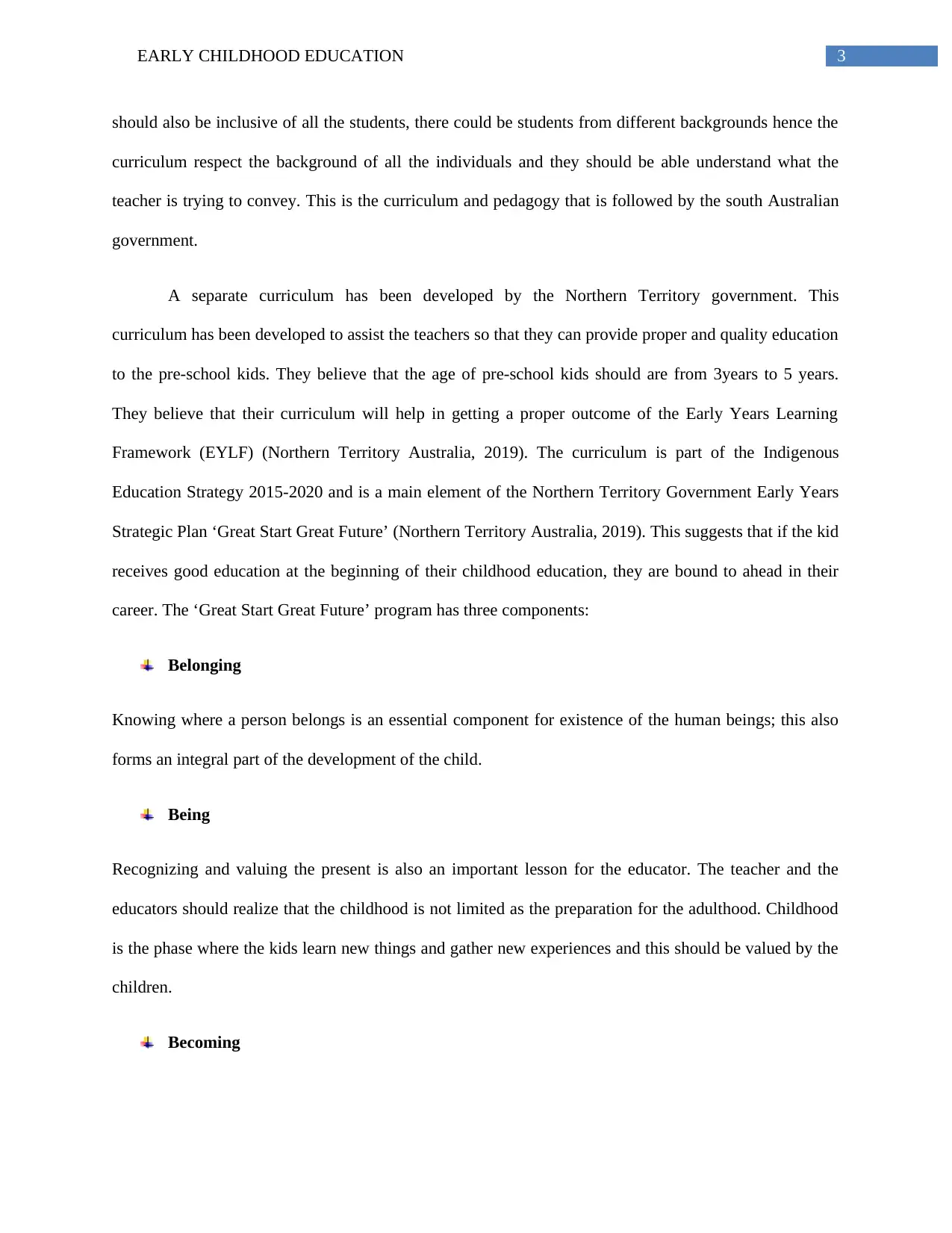
3EARLY CHILDHOOD EDUCATION
should also be inclusive of all the students, there could be students from different backgrounds hence the
curriculum respect the background of all the individuals and they should be able understand what the
teacher is trying to convey. This is the curriculum and pedagogy that is followed by the south Australian
government.
A separate curriculum has been developed by the Northern Territory government. This
curriculum has been developed to assist the teachers so that they can provide proper and quality education
to the pre-school kids. They believe that the age of pre-school kids should are from 3years to 5 years.
They believe that their curriculum will help in getting a proper outcome of the Early Years Learning
Framework (EYLF) (Northern Territory Australia, 2019). The curriculum is part of the Indigenous
Education Strategy 2015-2020 and is a main element of the Northern Territory Government Early Years
Strategic Plan ‘Great Start Great Future’ (Northern Territory Australia, 2019). This suggests that if the kid
receives good education at the beginning of their childhood education, they are bound to ahead in their
career. The ‘Great Start Great Future’ program has three components:
Belonging
Knowing where a person belongs is an essential component for existence of the human beings; this also
forms an integral part of the development of the child.
Being
Recognizing and valuing the present is also an important lesson for the educator. The teacher and the
educators should realize that the childhood is not limited as the preparation for the adulthood. Childhood
is the phase where the kids learn new things and gather new experiences and this should be valued by the
children.
Becoming
should also be inclusive of all the students, there could be students from different backgrounds hence the
curriculum respect the background of all the individuals and they should be able understand what the
teacher is trying to convey. This is the curriculum and pedagogy that is followed by the south Australian
government.
A separate curriculum has been developed by the Northern Territory government. This
curriculum has been developed to assist the teachers so that they can provide proper and quality education
to the pre-school kids. They believe that the age of pre-school kids should are from 3years to 5 years.
They believe that their curriculum will help in getting a proper outcome of the Early Years Learning
Framework (EYLF) (Northern Territory Australia, 2019). The curriculum is part of the Indigenous
Education Strategy 2015-2020 and is a main element of the Northern Territory Government Early Years
Strategic Plan ‘Great Start Great Future’ (Northern Territory Australia, 2019). This suggests that if the kid
receives good education at the beginning of their childhood education, they are bound to ahead in their
career. The ‘Great Start Great Future’ program has three components:
Belonging
Knowing where a person belongs is an essential component for existence of the human beings; this also
forms an integral part of the development of the child.
Being
Recognizing and valuing the present is also an important lesson for the educator. The teacher and the
educators should realize that the childhood is not limited as the preparation for the adulthood. Childhood
is the phase where the kids learn new things and gather new experiences and this should be valued by the
children.
Becoming
Paraphrase This Document
Need a fresh take? Get an instant paraphrase of this document with our AI Paraphraser
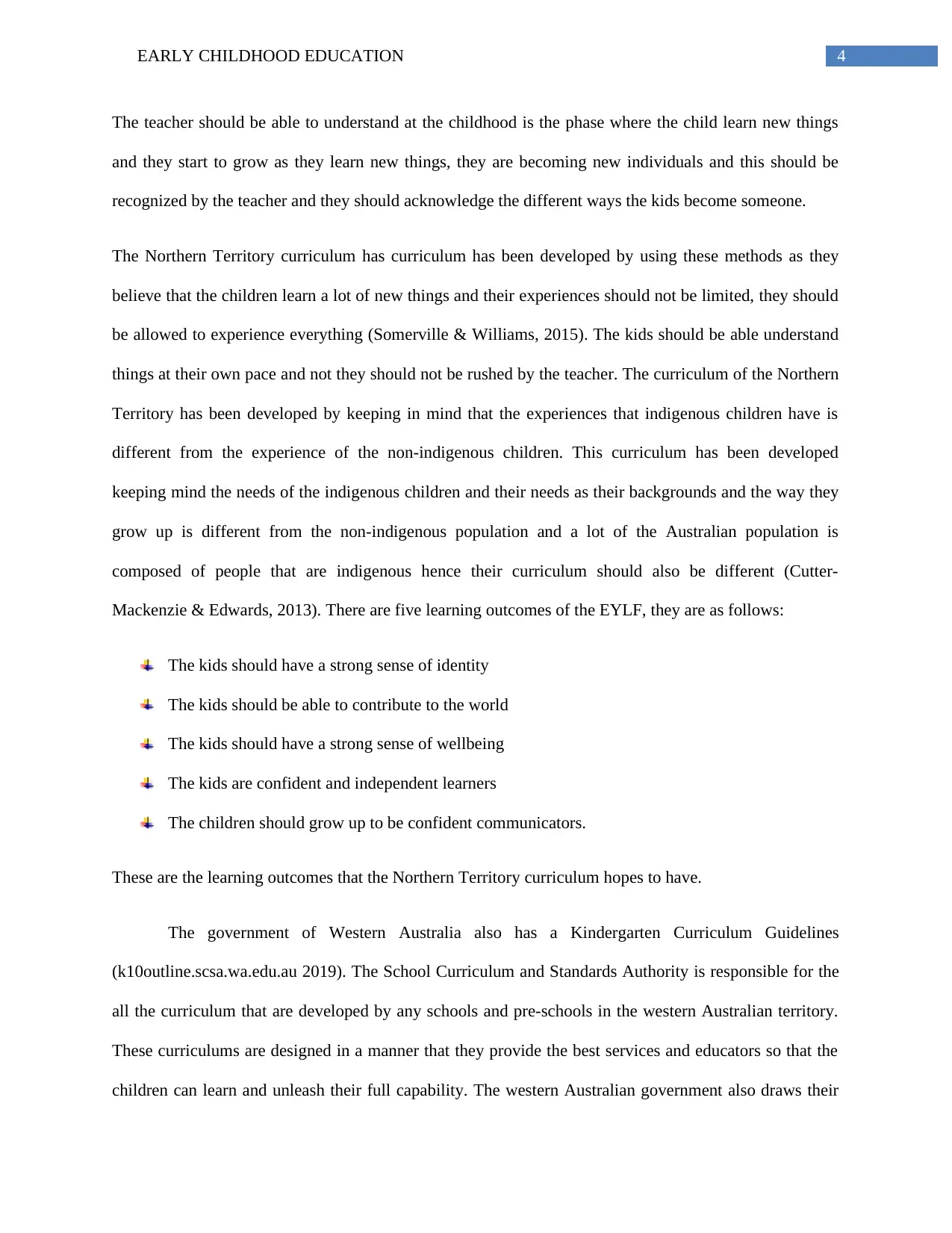
4EARLY CHILDHOOD EDUCATION
The teacher should be able to understand at the childhood is the phase where the child learn new things
and they start to grow as they learn new things, they are becoming new individuals and this should be
recognized by the teacher and they should acknowledge the different ways the kids become someone.
The Northern Territory curriculum has curriculum has been developed by using these methods as they
believe that the children learn a lot of new things and their experiences should not be limited, they should
be allowed to experience everything (Somerville & Williams, 2015). The kids should be able understand
things at their own pace and not they should not be rushed by the teacher. The curriculum of the Northern
Territory has been developed by keeping in mind that the experiences that indigenous children have is
different from the experience of the non-indigenous children. This curriculum has been developed
keeping mind the needs of the indigenous children and their needs as their backgrounds and the way they
grow up is different from the non-indigenous population and a lot of the Australian population is
composed of people that are indigenous hence their curriculum should also be different (Cutter-
Mackenzie & Edwards, 2013). There are five learning outcomes of the EYLF, they are as follows:
The kids should have a strong sense of identity
The kids should be able to contribute to the world
The kids should have a strong sense of wellbeing
The kids are confident and independent learners
The children should grow up to be confident communicators.
These are the learning outcomes that the Northern Territory curriculum hopes to have.
The government of Western Australia also has a Kindergarten Curriculum Guidelines
(k10outline.scsa.wa.edu.au 2019). The School Curriculum and Standards Authority is responsible for the
all the curriculum that are developed by any schools and pre-schools in the western Australian territory.
These curriculums are designed in a manner that they provide the best services and educators so that the
children can learn and unleash their full capability. The western Australian government also draws their
The teacher should be able to understand at the childhood is the phase where the child learn new things
and they start to grow as they learn new things, they are becoming new individuals and this should be
recognized by the teacher and they should acknowledge the different ways the kids become someone.
The Northern Territory curriculum has curriculum has been developed by using these methods as they
believe that the children learn a lot of new things and their experiences should not be limited, they should
be allowed to experience everything (Somerville & Williams, 2015). The kids should be able understand
things at their own pace and not they should not be rushed by the teacher. The curriculum of the Northern
Territory has been developed by keeping in mind that the experiences that indigenous children have is
different from the experience of the non-indigenous children. This curriculum has been developed
keeping mind the needs of the indigenous children and their needs as their backgrounds and the way they
grow up is different from the non-indigenous population and a lot of the Australian population is
composed of people that are indigenous hence their curriculum should also be different (Cutter-
Mackenzie & Edwards, 2013). There are five learning outcomes of the EYLF, they are as follows:
The kids should have a strong sense of identity
The kids should be able to contribute to the world
The kids should have a strong sense of wellbeing
The kids are confident and independent learners
The children should grow up to be confident communicators.
These are the learning outcomes that the Northern Territory curriculum hopes to have.
The government of Western Australia also has a Kindergarten Curriculum Guidelines
(k10outline.scsa.wa.edu.au 2019). The School Curriculum and Standards Authority is responsible for the
all the curriculum that are developed by any schools and pre-schools in the western Australian territory.
These curriculums are designed in a manner that they provide the best services and educators so that the
children can learn and unleash their full capability. The western Australian government also draws their
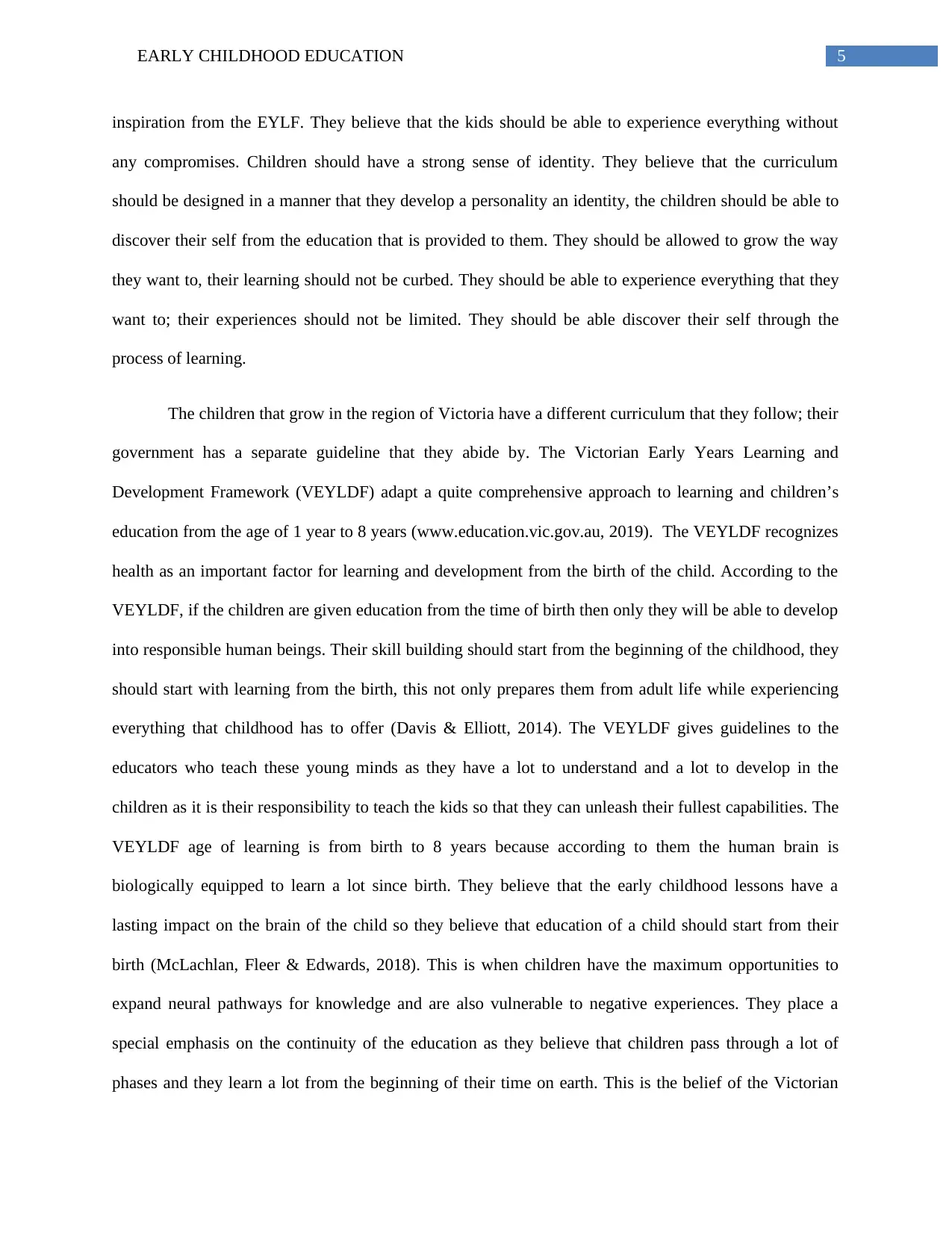
5EARLY CHILDHOOD EDUCATION
inspiration from the EYLF. They believe that the kids should be able to experience everything without
any compromises. Children should have a strong sense of identity. They believe that the curriculum
should be designed in a manner that they develop a personality an identity, the children should be able to
discover their self from the education that is provided to them. They should be allowed to grow the way
they want to, their learning should not be curbed. They should be able to experience everything that they
want to; their experiences should not be limited. They should be able discover their self through the
process of learning.
The children that grow in the region of Victoria have a different curriculum that they follow; their
government has a separate guideline that they abide by. The Victorian Early Years Learning and
Development Framework (VEYLDF) adapt a quite comprehensive approach to learning and children’s
education from the age of 1 year to 8 years (www.education.vic.gov.au, 2019). The VEYLDF recognizes
health as an important factor for learning and development from the birth of the child. According to the
VEYLDF, if the children are given education from the time of birth then only they will be able to develop
into responsible human beings. Their skill building should start from the beginning of the childhood, they
should start with learning from the birth, this not only prepares them from adult life while experiencing
everything that childhood has to offer (Davis & Elliott, 2014). The VEYLDF gives guidelines to the
educators who teach these young minds as they have a lot to understand and a lot to develop in the
children as it is their responsibility to teach the kids so that they can unleash their fullest capabilities. The
VEYLDF age of learning is from birth to 8 years because according to them the human brain is
biologically equipped to learn a lot since birth. They believe that the early childhood lessons have a
lasting impact on the brain of the child so they believe that education of a child should start from their
birth (McLachlan, Fleer & Edwards, 2018). This is when children have the maximum opportunities to
expand neural pathways for knowledge and are also vulnerable to negative experiences. They place a
special emphasis on the continuity of the education as they believe that children pass through a lot of
phases and they learn a lot from the beginning of their time on earth. This is the belief of the Victorian
inspiration from the EYLF. They believe that the kids should be able to experience everything without
any compromises. Children should have a strong sense of identity. They believe that the curriculum
should be designed in a manner that they develop a personality an identity, the children should be able to
discover their self from the education that is provided to them. They should be allowed to grow the way
they want to, their learning should not be curbed. They should be able to experience everything that they
want to; their experiences should not be limited. They should be able discover their self through the
process of learning.
The children that grow in the region of Victoria have a different curriculum that they follow; their
government has a separate guideline that they abide by. The Victorian Early Years Learning and
Development Framework (VEYLDF) adapt a quite comprehensive approach to learning and children’s
education from the age of 1 year to 8 years (www.education.vic.gov.au, 2019). The VEYLDF recognizes
health as an important factor for learning and development from the birth of the child. According to the
VEYLDF, if the children are given education from the time of birth then only they will be able to develop
into responsible human beings. Their skill building should start from the beginning of the childhood, they
should start with learning from the birth, this not only prepares them from adult life while experiencing
everything that childhood has to offer (Davis & Elliott, 2014). The VEYLDF gives guidelines to the
educators who teach these young minds as they have a lot to understand and a lot to develop in the
children as it is their responsibility to teach the kids so that they can unleash their fullest capabilities. The
VEYLDF age of learning is from birth to 8 years because according to them the human brain is
biologically equipped to learn a lot since birth. They believe that the early childhood lessons have a
lasting impact on the brain of the child so they believe that education of a child should start from their
birth (McLachlan, Fleer & Edwards, 2018). This is when children have the maximum opportunities to
expand neural pathways for knowledge and are also vulnerable to negative experiences. They place a
special emphasis on the continuity of the education as they believe that children pass through a lot of
phases and they learn a lot from the beginning of their time on earth. This is the belief of the Victorian
⊘ This is a preview!⊘
Do you want full access?
Subscribe today to unlock all pages.

Trusted by 1+ million students worldwide
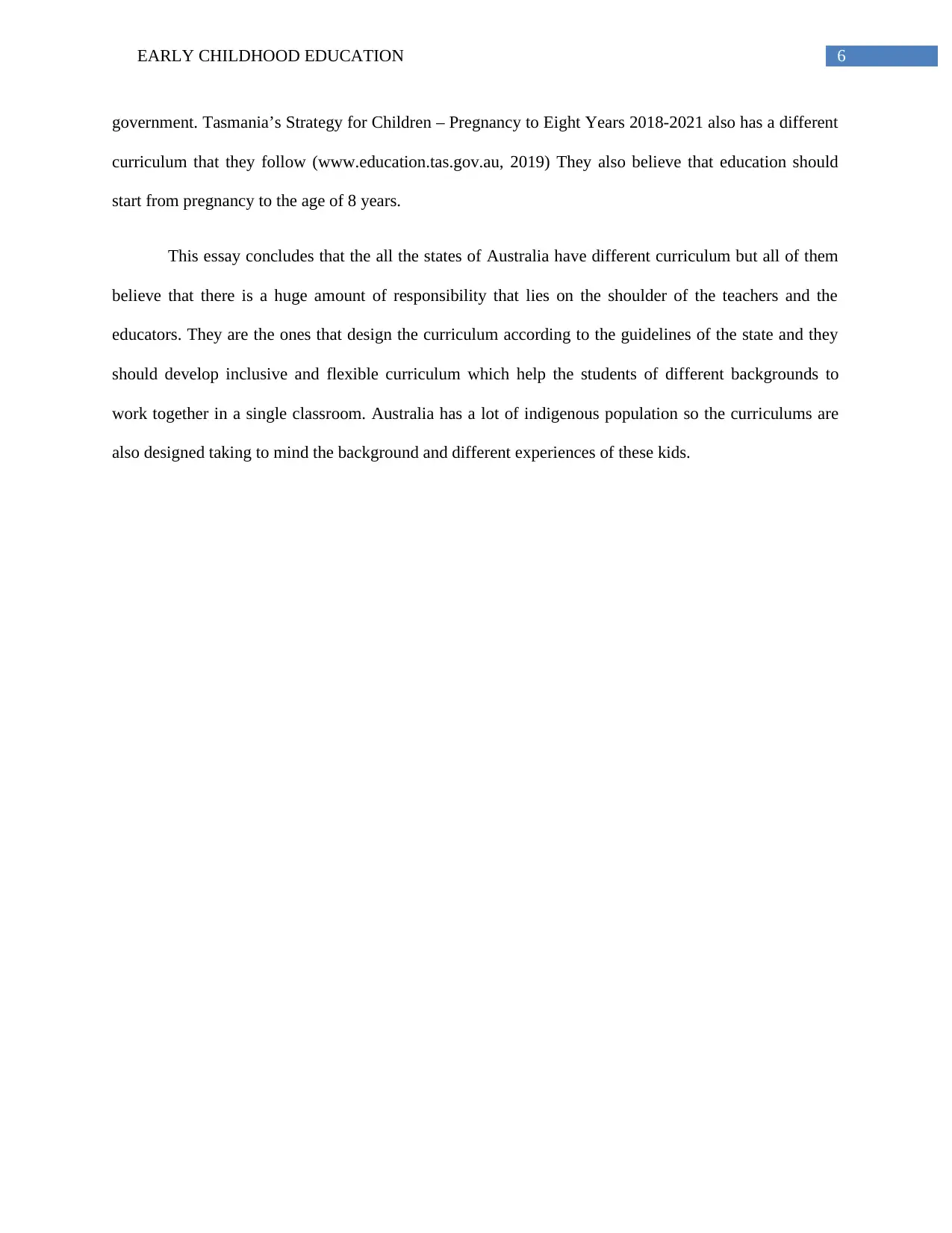
6EARLY CHILDHOOD EDUCATION
government. Tasmania’s Strategy for Children – Pregnancy to Eight Years 2018-2021 also has a different
curriculum that they follow (www.education.tas.gov.au, 2019) They also believe that education should
start from pregnancy to the age of 8 years.
This essay concludes that the all the states of Australia have different curriculum but all of them
believe that there is a huge amount of responsibility that lies on the shoulder of the teachers and the
educators. They are the ones that design the curriculum according to the guidelines of the state and they
should develop inclusive and flexible curriculum which help the students of different backgrounds to
work together in a single classroom. Australia has a lot of indigenous population so the curriculums are
also designed taking to mind the background and different experiences of these kids.
government. Tasmania’s Strategy for Children – Pregnancy to Eight Years 2018-2021 also has a different
curriculum that they follow (www.education.tas.gov.au, 2019) They also believe that education should
start from pregnancy to the age of 8 years.
This essay concludes that the all the states of Australia have different curriculum but all of them
believe that there is a huge amount of responsibility that lies on the shoulder of the teachers and the
educators. They are the ones that design the curriculum according to the guidelines of the state and they
should develop inclusive and flexible curriculum which help the students of different backgrounds to
work together in a single classroom. Australia has a lot of indigenous population so the curriculums are
also designed taking to mind the background and different experiences of these kids.
Paraphrase This Document
Need a fresh take? Get an instant paraphrase of this document with our AI Paraphraser
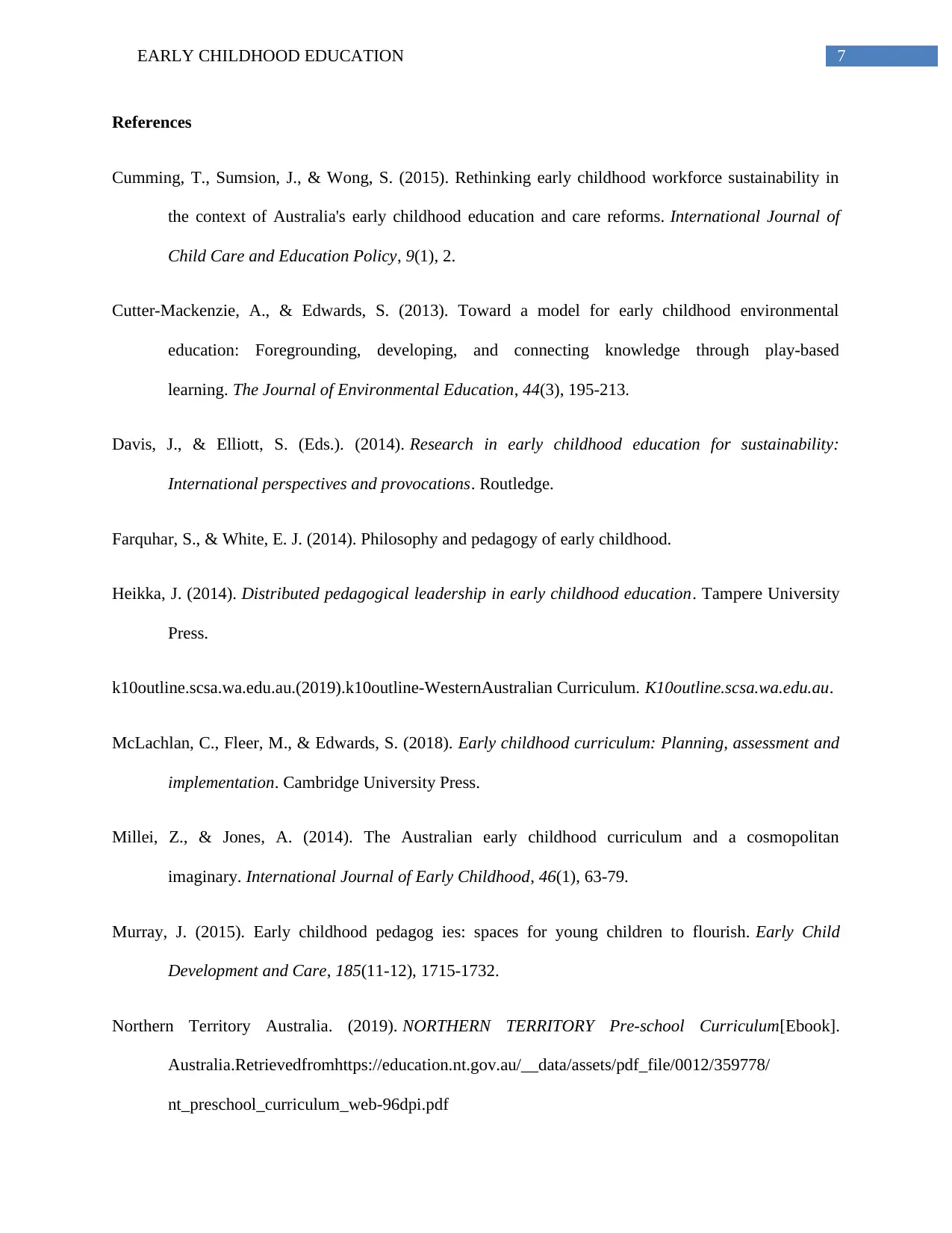
7EARLY CHILDHOOD EDUCATION
References
Cumming, T., Sumsion, J., & Wong, S. (2015). Rethinking early childhood workforce sustainability in
the context of Australia's early childhood education and care reforms. International Journal of
Child Care and Education Policy, 9(1), 2.
Cutter-Mackenzie, A., & Edwards, S. (2013). Toward a model for early childhood environmental
education: Foregrounding, developing, and connecting knowledge through play-based
learning. The Journal of Environmental Education, 44(3), 195-213.
Davis, J., & Elliott, S. (Eds.). (2014). Research in early childhood education for sustainability:
International perspectives and provocations. Routledge.
Farquhar, S., & White, E. J. (2014). Philosophy and pedagogy of early childhood.
Heikka, J. (2014). Distributed pedagogical leadership in early childhood education. Tampere University
Press.
k10outline.scsa.wa.edu.au.(2019).k10outline-WesternAustralian Curriculum. K10outline.scsa.wa.edu.au.
McLachlan, C., Fleer, M., & Edwards, S. (2018). Early childhood curriculum: Planning, assessment and
implementation. Cambridge University Press.
Millei, Z., & Jones, A. (2014). The Australian early childhood curriculum and a cosmopolitan
imaginary. International Journal of Early Childhood, 46(1), 63-79.
Murray, J. (2015). Early childhood pedagog ies: spaces for young children to flourish. Early Child
Development and Care, 185(11-12), 1715-1732.
Northern Territory Australia. (2019). NORTHERN TERRITORY Pre-school Curriculum[Ebook].
Australia.Retrievedfromhttps://education.nt.gov.au/__data/assets/pdf_file/0012/359778/
nt_preschool_curriculum_web-96dpi.pdf
References
Cumming, T., Sumsion, J., & Wong, S. (2015). Rethinking early childhood workforce sustainability in
the context of Australia's early childhood education and care reforms. International Journal of
Child Care and Education Policy, 9(1), 2.
Cutter-Mackenzie, A., & Edwards, S. (2013). Toward a model for early childhood environmental
education: Foregrounding, developing, and connecting knowledge through play-based
learning. The Journal of Environmental Education, 44(3), 195-213.
Davis, J., & Elliott, S. (Eds.). (2014). Research in early childhood education for sustainability:
International perspectives and provocations. Routledge.
Farquhar, S., & White, E. J. (2014). Philosophy and pedagogy of early childhood.
Heikka, J. (2014). Distributed pedagogical leadership in early childhood education. Tampere University
Press.
k10outline.scsa.wa.edu.au.(2019).k10outline-WesternAustralian Curriculum. K10outline.scsa.wa.edu.au.
McLachlan, C., Fleer, M., & Edwards, S. (2018). Early childhood curriculum: Planning, assessment and
implementation. Cambridge University Press.
Millei, Z., & Jones, A. (2014). The Australian early childhood curriculum and a cosmopolitan
imaginary. International Journal of Early Childhood, 46(1), 63-79.
Murray, J. (2015). Early childhood pedagog ies: spaces for young children to flourish. Early Child
Development and Care, 185(11-12), 1715-1732.
Northern Territory Australia. (2019). NORTHERN TERRITORY Pre-school Curriculum[Ebook].
Australia.Retrievedfromhttps://education.nt.gov.au/__data/assets/pdf_file/0012/359778/
nt_preschool_curriculum_web-96dpi.pdf
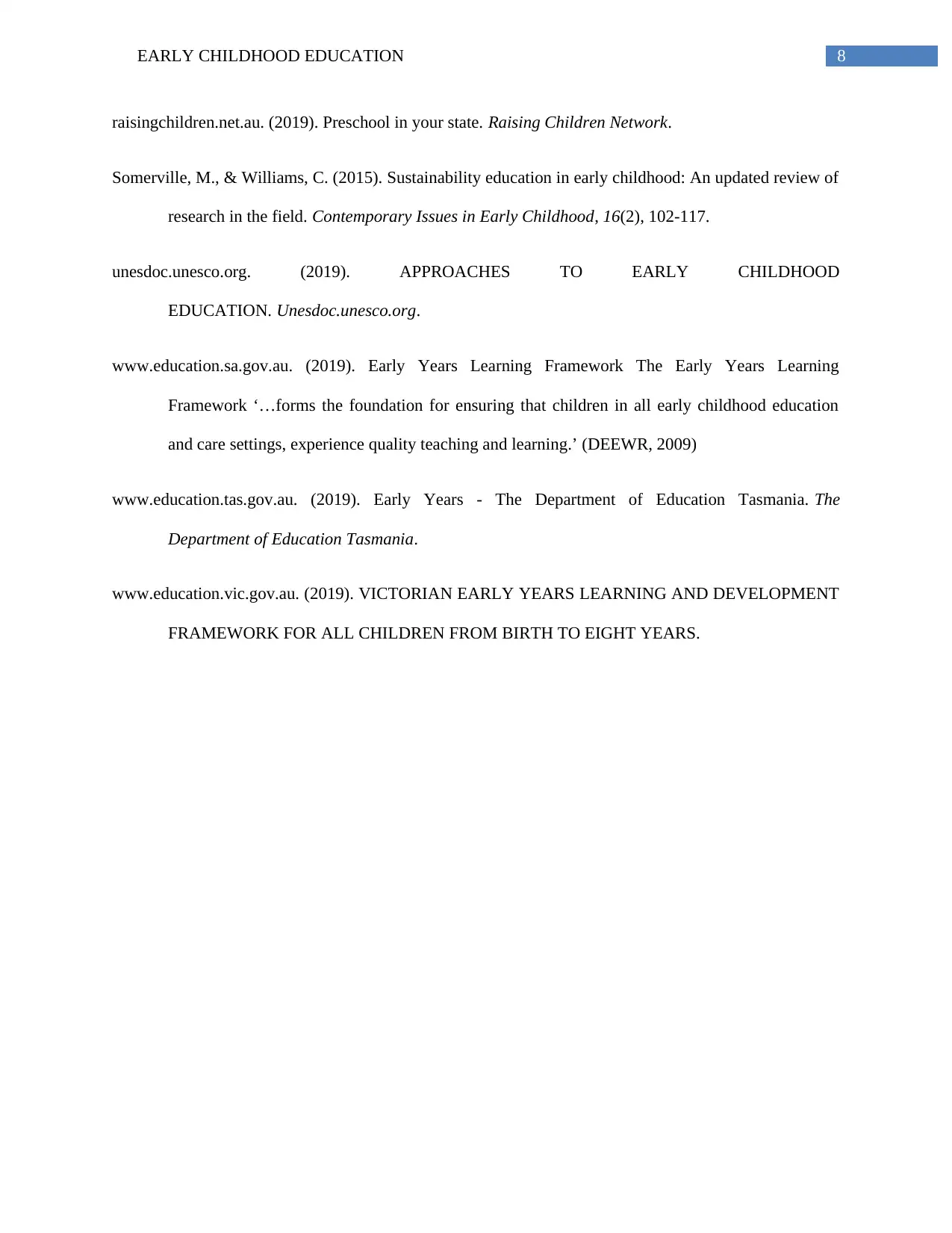
8EARLY CHILDHOOD EDUCATION
raisingchildren.net.au. (2019). Preschool in your state. Raising Children Network.
Somerville, M., & Williams, C. (2015). Sustainability education in early childhood: An updated review of
research in the field. Contemporary Issues in Early Childhood, 16(2), 102-117.
unesdoc.unesco.org. (2019). APPROACHES TO EARLY CHILDHOOD
EDUCATION. Unesdoc.unesco.org.
www.education.sa.gov.au. (2019). Early Years Learning Framework The Early Years Learning
Framework ‘…forms the foundation for ensuring that children in all early childhood education
and care settings, experience quality teaching and learning.’ (DEEWR, 2009)
www.education.tas.gov.au. (2019). Early Years - The Department of Education Tasmania. The
Department of Education Tasmania.
www.education.vic.gov.au. (2019). VICTORIAN EARLY YEARS LEARNING AND DEVELOPMENT
FRAMEWORK FOR ALL CHILDREN FROM BIRTH TO EIGHT YEARS.
raisingchildren.net.au. (2019). Preschool in your state. Raising Children Network.
Somerville, M., & Williams, C. (2015). Sustainability education in early childhood: An updated review of
research in the field. Contemporary Issues in Early Childhood, 16(2), 102-117.
unesdoc.unesco.org. (2019). APPROACHES TO EARLY CHILDHOOD
EDUCATION. Unesdoc.unesco.org.
www.education.sa.gov.au. (2019). Early Years Learning Framework The Early Years Learning
Framework ‘…forms the foundation for ensuring that children in all early childhood education
and care settings, experience quality teaching and learning.’ (DEEWR, 2009)
www.education.tas.gov.au. (2019). Early Years - The Department of Education Tasmania. The
Department of Education Tasmania.
www.education.vic.gov.au. (2019). VICTORIAN EARLY YEARS LEARNING AND DEVELOPMENT
FRAMEWORK FOR ALL CHILDREN FROM BIRTH TO EIGHT YEARS.
⊘ This is a preview!⊘
Do you want full access?
Subscribe today to unlock all pages.

Trusted by 1+ million students worldwide
1 out of 9
Related Documents
Your All-in-One AI-Powered Toolkit for Academic Success.
+13062052269
info@desklib.com
Available 24*7 on WhatsApp / Email
![[object Object]](/_next/static/media/star-bottom.7253800d.svg)
Unlock your academic potential
Copyright © 2020–2025 A2Z Services. All Rights Reserved. Developed and managed by ZUCOL.





